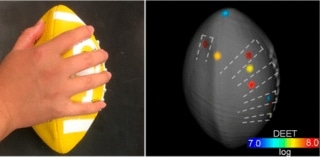Apr 5 2018
In the last decade, many developments have been made in the 3D market, such as from printing to movies. At present, researchers have reported in the Analytical Chemistry journal, published by ACS, that when a robotic arm is combined with mass spectrometry (MS), it enables the analysis of the surface of 3D objects with irregular shapes, potentially opening the door for innovative branches of forensics and pharmaceutics.
 By combining a robotic arm and mass spectrometry, researchers can analyze the surface of 3D objects, such as footballs. (Image credit: American Chemical Society)
By combining a robotic arm and mass spectrometry, researchers can analyze the surface of 3D objects, such as footballs. (Image credit: American Chemical Society)
MS is a tool that assists scientists in identifying the components of a sample. In the recent past, apart from being used in the laboratory, the instrument has also been used in forensics and drug screening. However, prevalent MS methods do not have the ability to investigate bulky, large, curved objects without a great deal of human intervention.
Earlier, Facundo M. Fernández and his team carried out a proof-of-concept analysis to demonstrate that a 3D infrared camera could control a robotic arm to gather samples for plasma ionization MS analysis; however, only specific types of molecules could be investigated by adopting the technique. In this study, the researchers desired to expand on this concept of direct surface sampling of 3D objects that are irregularly shaped.
The team devised a new technique called robotic surface analysis MS (RoSA-MS). In order to perform this, a custom-built laser scanner was affixed to a force-sensing robotic arm. The laser scanner developed a digital map of the surface of the sample, which controlled a spring-loaded sampling probe, which is also attached to the arm, to move to specific locations. The probe briefly made contact with the surfaces of objects and gathered trace amounts of the material.
Once the sample was collected, the arm positioned the probe into an electrospray ionization mass spectrometer that has the ability to investigate a broad array of samples. The team remarked that the probe can be customized for different applications. For instance, the researchers used RoSA-MS to detect the presence of caffeine on the surface of a plastic coffee cup and to identify the locations of pesticide residue on a small football.
Funding from the National Science Foundation and the National Science Foundation Center for Chemical Evolution is acknowledged by the authors of this study.